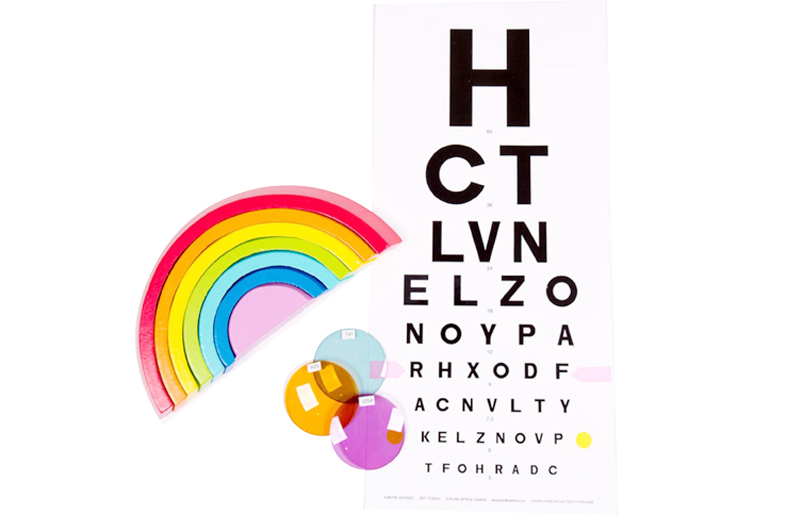What is Irlen Syndrome?
Overview
Irlen Syndrome, also known as Scotopic Sensitivity, is a perceptual processing disorder which affects how the brain perceives light. It occurs when the brain’s sensitivity to particular light wavelengths prevents it from correctly processing visual information from the eyes. The brain becomes overactive when exposed to particular wavelengths of light, resulting in visual sensory overload. Sometimes this can also appear as light sensitivity, but is it much more complex than that.
Often mis-diagnosed as dyslexia, ADHD, or behavioural problems, Irlen Syndrome affects between 11-14% of the general population, and about 60% of those with other learning difficulties.
Irlen Syndrome affects the way that individuals process visual information, which means they see things different to how they really appear. The visual system causes normal things we see to become distorted affecting the way individuals go about their daily tasks and can manifest in a whole range of different ways. Words can appear to be flashing, moving, blurring, or doubling up on a page. For some people the letters can swirl, shimmer, appear three dimensional or even seem to lift off or sink into the page. Individuals with Irlen tire more easily from routine tasks involving vision as the brain requires significant effort to process and make sense of sensory information. As a result, simple tasks such as reading can become extremely challenging. This over-activity of the brain contributes to the diverse symptoms often associated with the condition.
Physical symptoms can include:
- Sensitivity to light
- Eye strain
- Watery eyes and a need to rub them
- Headaches and migraines
- Fatigue
- Nausea, motion sickness or dizziness
Visual symptoms can include:
- Text moving on the page
- Difficulty focussing on the right text
- Blurred vision
- Sensations of swirling, flashing, moving text
- Difficulty viewing patterns or contrasting colours
- Text jumping off the page, or sinking into it
- Difficulty judging the speed and distance of objects
Associated disorders
Irlen Syndrome is often associated with dyslexia due to their shared symptoms, but they are actually separate disorders. That doesn’t mean that some individuals won’t have both disabilities. There is a significant crossover with other sensory or attention processing disorders such as ADHD, audio-processing disorder, or autistic spectrum disorders. In addition, it can be synonymous with other learning disorders such as dyspraxia (a developmental coordination disorder), dysgraphia (a condition which impairs writing ability), and dyscalculia (difficulty learning or understanding mathematics). The impact on individuals is immense and for some, it may serve as a lifelong obstacle to learning and achievement.
Causes
In most cases, people are born with Irlen Syndrome as it is a hereditary disorder. However, other events such as concussions, strokes, or head injuries from sport or service in the military can affect visual processing regions of the brain, leading to the development of the disorder. It is thought that 35% of individuals with Irlen Syndrome have suffered a concussion or traumatic brain injury. Unfortunately it is common for individuals to experience difficulties in many different areas of life, before being diagnosed as having Irlen Syndrome. This is why early diagnosis and treatment is essential to improve sight and perception and relieve symptomatic difficulties.Impact of Irlen Syndrome on general livelihood and wellbeing

Since vision plays a large role in all of our lives, especially in the realms of learning and education, Irlen Syndrome can hinder an individual’s ability to progress in many areas.
Numerous aspects of life are impacted by Irlen Syndrome, including:
- Academic and work performance
- Behaviour
- Attention and concentration difficulties
- Individual’s ability to sit still
- Physical environment can appear differently
- Slow or inefficient reading, especially print with smaller text and many lines
- Difficulty writing neatly or staying on the line
- Poor comprehension
- Poor depth-perception: things may appear closer or further than they actually are
- Decreased motivation
- Poor self-esteem and confidence
- Increased anxiety levels
- Nausea and the sensation of motion sickness even when not moving
Treatment
The encouraging news is that Irlen Syndrome can be treated! Diagnosis and treatment involves a combination of screening tests with a certified practitioner as well as a comprehensive eye examination with an optometrist. This process leads to the creation of customised glasses, which filter out the wavelengths of light that are problematic for the individual.
When these individually-prescribed, precision-tinted coloured filters are worn, cognitive activity can return to normal as it can more easily make sense of the visual information that it receives. By easing the strain on the brain’s sensory processing pathways, this enables clients to resume their normal activities with corrected eyesight. Additionally, brain imaging studies have shown that these personalised spectrum glasses filter visual information in a way which helps to relax and stabilise brain activity. As a result, this may help to improve their abilities and performance in various activities.

Frequently Asked Questions
At what age can children be tested?
The general rule is from 7 years of age. Children under 7 often have difficulty comprehending the questions and what is required during testing. However, every child is different. Contact Sam if you have a child under 7 and she’ll recommend some strategies until they are old enough.
How did I get Irlen Syndrome?
What if my child has Autism or ADHD?
What if I am colour blind?
Can't I just get coloured glasses or contact lenses from my optometrist?
I've seen my optometrist, but I don't need glasses. Could I still have Irlen Syndrome?
I've just purchased new glasses. Will I need to buy another pair now?
I don't have trouble seeing things on the page, but I do have light sensitivity. Can Irlen filters help me?
Has the Irlen method been researched?
Yes. There have been many research papers and studies published in peer-reviewed journals including studies on changes to reading rate, accuracy, and comprehension. As well as this, there is medical and biochemical research documenting the existence of Irlen Syndrome, and the positive changes experienced by wearing Irlen Filters. Irlen Research about the research here.

Book an Irlen test today
The Eye Lady
41 Hobson Ave, Kerikeri
(located at Kerikeri Baptist Church)
Send a message